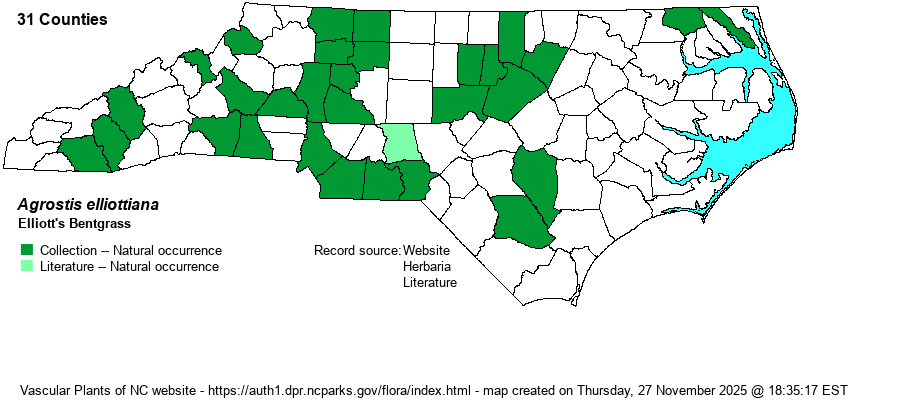| Author | J.A. Schultes | |
| Distribution | Mountains and Piedmont; a few records scattered on the Coastal Plain. The various gaps are likely not meaningful.
PA to eastern KS, south to northwestern FL and central TX. | |
| Abundance | Uncommon to infrequent in the Mountains and Piedmont; rare in the Coastal Plain. The website editors suggest a State Rank of S3S4. | |
| Habitat | Dry fields, barrens, rock outcrops. | |
| Phenology | Flowering and fruiting April-June. | |
| Identification | With its broad and open inflorescence (about half the entire height of the plant), it resembles A. hyemalis and A. scabra; however, it differs in being annual (vs. perennial), with a single anther (vs. 3), and with lemmas usually awned and 4-10 mm long (vs. no awns or awns at most 3 mm long in the others). | |
| Taxonomic Comments | None
Bentgrasses, genus Agrostis, in NC are usually densely cespitose (many stems and basal leaves from a central area). Most leaves are basal, rather short, and slender, often folded lengthwise or involute (rounded in cross-section). Stem leaves are few in number. The inflorescence is open and airy or wispy, with 2-several branches from well-spaced nodes; towards their ends, these branches are again branched and support the spikelets. Spikelets each contain only a single floret, with 2 glumes (outer scale-like bodies) and one lemma (inner scale-like body) and a central fruit or seed. Glumes and lemmas are sharp pointed. Lemmas may or may not have a projecting awn. In grasses, the fruit is called a caryopsis or a grain; it is composed of the seed and a tightly fitting envelope (or pericarp). | |
| Other Common Name(s) | None | |
| State Rank | S3? [S3S4] | |
| Global Rank | G5 | |
| State Status | | |
| US Status | | |
| USACE-agcp | FACU link |
| USACE-emp | FACU link |

